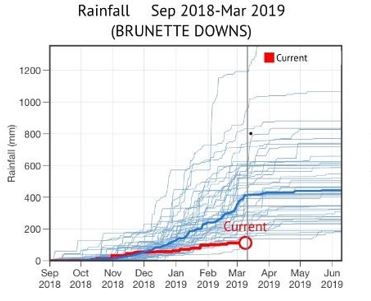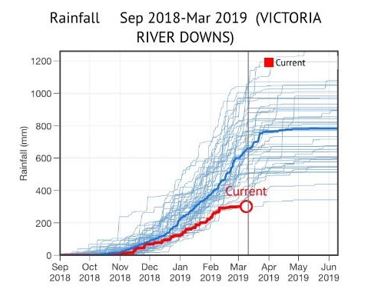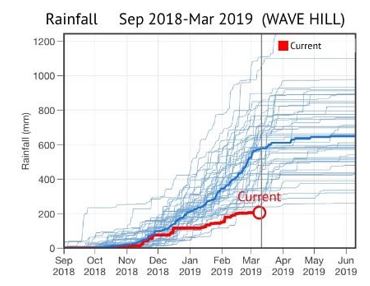Early weaning in drought conditions
Many parts of the NT have had disappointingly low rainfall totals over the 2018/19 wet season so far. In fact graphs from the CliMate application show that many properties are on track to have one of their worst wet seasons in the last 50 years. The graphs printed below show how the current wet season (the red line) compares to previous wet seasons and the average (the dark blue line) over the last 50 years for three locations.
During tough years when there is not much pasture available for cattle it is often a good management practice to start weaning calves earlier than normal to reduce the nutritional demands on cows. When cows are lactating, a lot of nutrients leave their body in the milk. When they don’t get enough nutrients from the pasture, they mobilise nutrients from their own body reserves to produce milk and as a result lose body condition. When this happens over an extended time they can become so poor that they stop cycling (resulting in low pregnancy rates) and can even be at risk of dying. This is especially the case in first lactation heifers and so they should be the first group weaned.
Weaning calves removes this nutrient drain and preserves the body condition of cows. It has been said that weaning a calf is equivalent to giving a cow a supplement of 2 kg of grain or 3 kg of fortified molasses every day. However, it is cheaper and easier to wean and feed calves than to supplementary feed cows with calves at foot for survival, particularly when not all cows in the mob require feeding (e.g. dry cows in reasonable condition).
While early weaning preserves the body condition of cows, some of the calves will need extra management if they are very young when weaned. Research in the NT has found that calves that are heavier than 100 kg at weaning do not require special supplementation provided they have access to good pasture. However calves that are lighter than 100 kg at weaning should receive some extra supplementation. In crisis situations calves can be weaned quite young (eg. down to 60 kg) however they will require special nutritional management and supplementary feeding. Calves weighing between 60-100 kg at weaning should be fed highly palatable calf meal or pellets. In extreme cases where calves less than 60 kg have to be weaned, they will require milk replacer and high quality baby calf meal or pellets. Basically the smaller the calf at weaning, the higher the nutritional requirement will be. Also it is a good idea to divide calves into groups based on weight and age for targeted supplementation and management.
What to feed weaners of different ages
Weaners: 1 to 4-5 weeks old
Ideally calves should not be weaned this young but in extreme circumstances it may be necessary, or orphaned calves may need to be fed. At this young age, a milk replacer is required as the rumen is not developed enough for baby calves to survive on a non-milk diet. It is important to feed milk from a teat rather than let calves drink directly from a bucket, because the suckling action closes off the oesophagus groove which prevents milk getting into the undeveloped rumen where it can ferment and cause scouring. Milk replacer should be fed at about 10 per cent of body weight per day, and calves need only be fed once a day from about one week of age. They should also be provided with ad lib (as much as they want) access to good quality hay and a high energy, high protein (18-21% crude protein (CP)), grain-based ration.
Weaners: 5 to 10 weeks of age
Most calves weigh between 50-75 kg at four to six weeks of age and 85-100 kg at 10 weeks. At this stage, there is generally no need for a milk replacer but rather a high energy (12-12.5MJ/kg Dry Matter (DM)), high protein (16-20% CP) grain-based diet with ad lib access to good quality hay is adequate. There are specifically designed calf pellets or meals available for early weaned calves of this age and they often control a coccidiostat to prevent scours.
If possible, calves of this age should gain 0.5 to 0.8 kg per head (hd) per day to ensure normal development and performance later in life. Intake of the grain based diet is likely to be 1 to 2.5 kg/hd/day across the weight range. Molasses based diets are not preferred for very young weaners as their digestive systems are not well enough developed (resulting in scours). However it can be used if other options are not available or the molasses mix is only a component of the diet. Urea should not be fed to very young calves as it can be toxic.
Weaners: 5 months and older
Typically weaners of this age weigh more than 100 kg and are considered 'normal' weaners and so don’t require special supplementary feeding as long as they have access to sufficient good quality pasture. However, supplementary feeding is still likely to be required if drought conditions have persisted. Suitable options include various commercial weaner mixes, molasses mixes, grain mixes, straight protein meal and whole cottonseed.
Weaner health
The health of weaners should be monitored closely and interventions made when necessary. It is a good idea to vaccinate for clostridial diseases (e.g. with “5-in-1”) at the first opportunity and to give a booster six weeks later. A botulism vaccination is also recommended at weaning. Early weaners are more susceptible to coccidiosis which causes ill-thrift, scours and even death in acute cases. Typical signs of the disease are blood stained faeces (scours), weakness and dehydration. If calves survive the five to six days of the disease, they become immune, but severely affected calves will remain poor doers. Prevention of coccidiosis through adequate hygiene, nutrition and the use of coccidiostats (e.g. Rumensin) is the best approach. Note that rumen modifiers such as Rumensin can be toxic if an animal ingests too much, so it is important to mix it in evenly.
Scours can also be caused by other microorganisms and digestive upsets. It is important to provide adequate hygiene and to treat affected animals promptly. Dehydration is common and can be managed through the use of electrolytes. Treatment for non-digestive upset scours usually consists of a program of oral treatments and perhaps antibiotics. Young stressed weaners may also be more susceptible to other sicknesses such as respiratory problems and pink-eye. These should be treated appropriately when observed. Consult your veterinarian if in doubt about the prevention and treatment of health problems in early weaned calves.
More information
There are some very good sources of information available on the internet for free download.
The Weaner management in northern beef herds booklet can be downloaded from the Meat and Livestock Australia website.
Dry season management of a beef business - a guide to planning, managing and supplementary feeding is a Queensland Department of Agriculture and Fisheries publication that is available from the FutureBeef website.
See the Queensland Department of Agriculture and Fisheries webpage on early weaning for additional information.
If you have any further questions please contact:
Tim Schatz, Principal Livestock Research Officer
Email: tim.schatz@nt.gov.au
Phone: (08) 8999 2332
Give feedback about this page.
Share this page:
URL copied!


